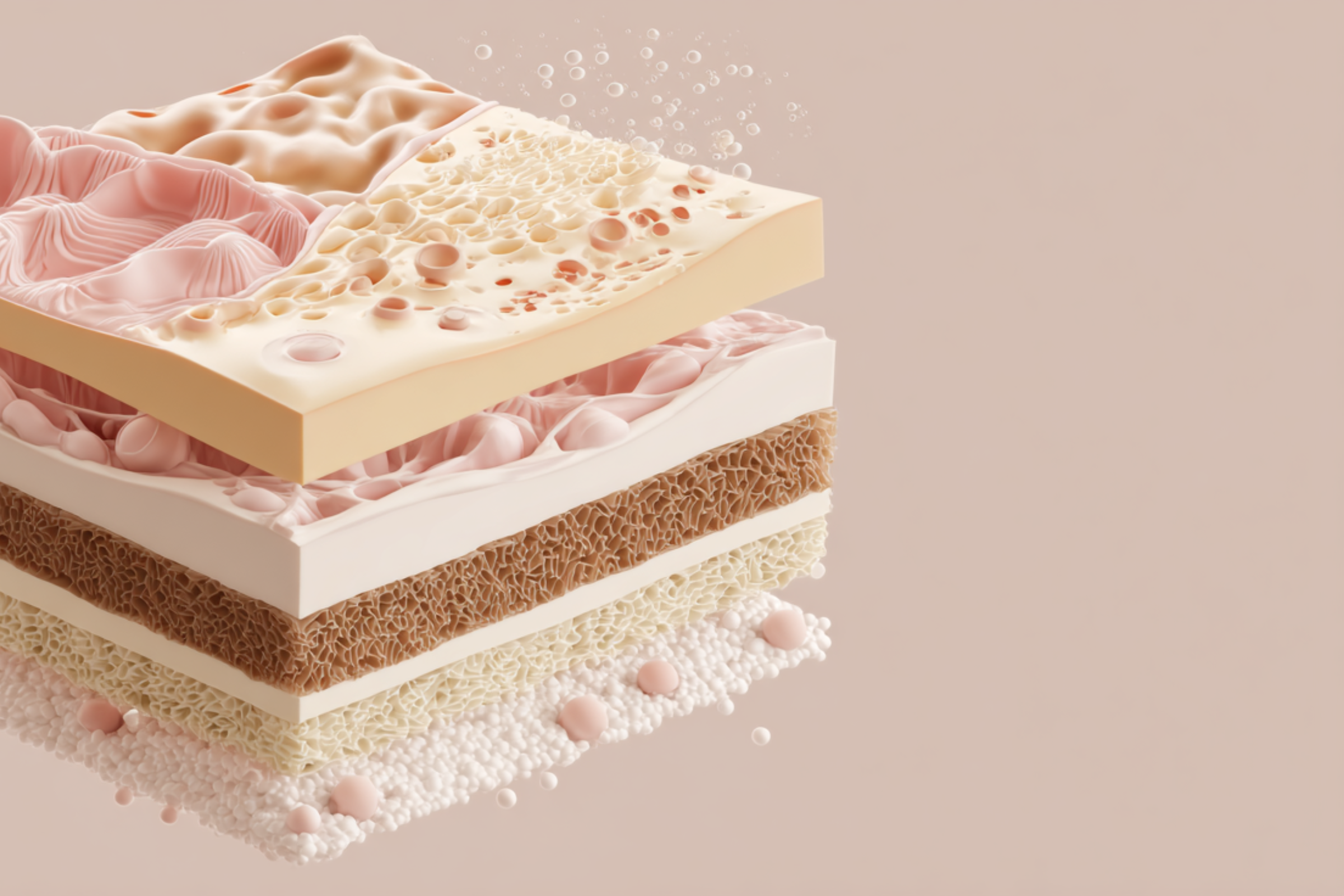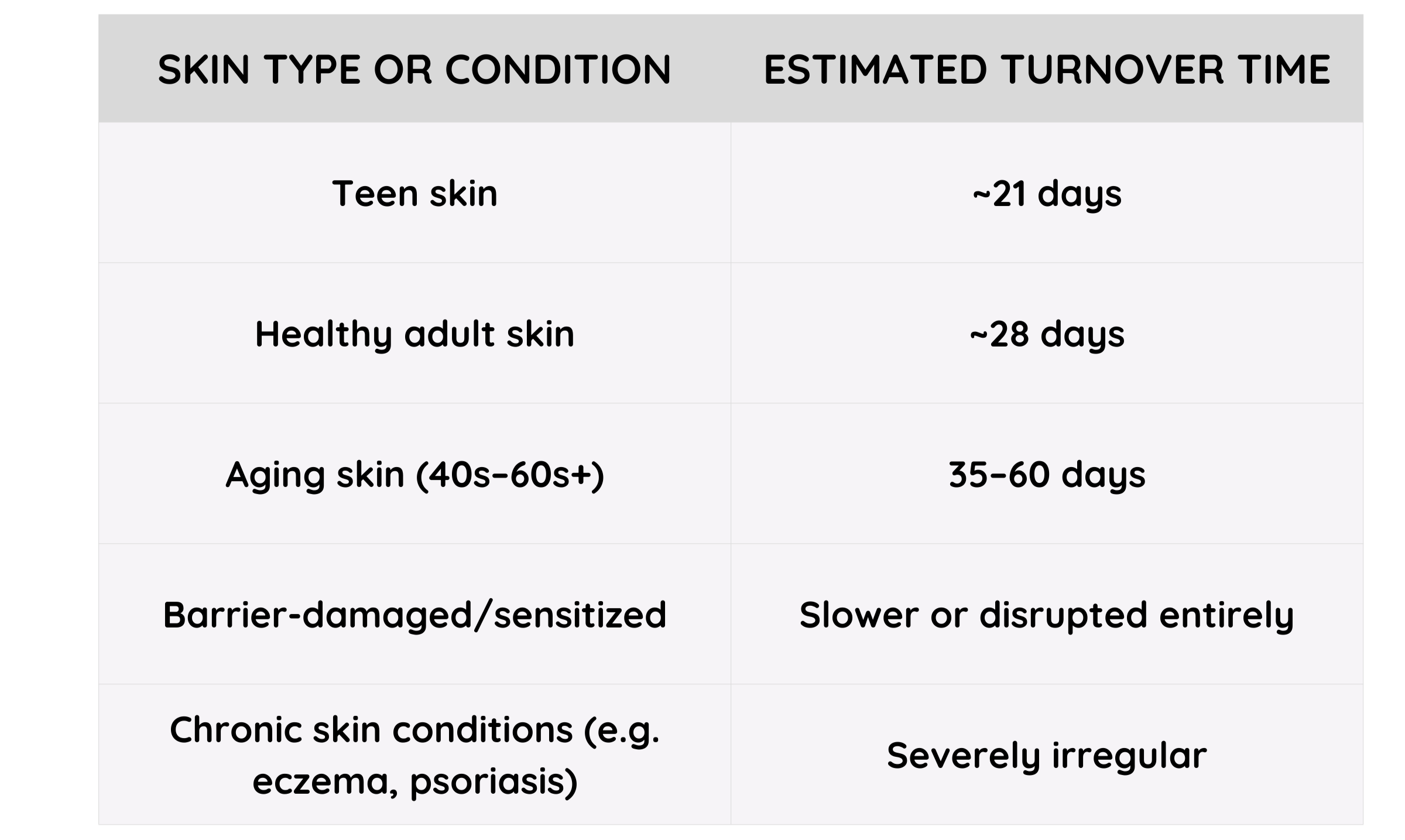

Your Skin Has a Rhythm
The skin follows a biological rhythm. Like hormones, sleep or our digestive system, the skin regenerates in cycles. This takes approximately 28 days.
This renewal process is why the skin recovers from irritation, fades pigmentation and responds to active ingredients over time.
Understanding the skin cycle is essential to understanding skincare. It explains why some products take weeks to show results, how your skin repairs itself after damage and what happens when your skin barrier is damaged or fragile.
What Is the Skin Cycle?
The skin cycle is the process where new skin cells form in the deepest layer of the epidermis and gradually move up until they shed from the surface. This turnover helps the skin stay renewed and repaired.
The Journey: From Birth to Shedding
The skin is made up of several layers, but the epidermis (the outermost layer) is where the cycle plays out. Within the epidermis, skin cells move through five key stages across four structured layers:
-
1. Stratum Basale - Days 1-5
(Basal Layer)
This is the stem cell zone of the skin.
New keratinocytes (the primary skin cells) are created through mitosis.
These fresh cells are round, metabolically active, ready to divide and begin their journey upward.
Melanocytes (pigment-producing cells) and Merkel cells (touch sensors) also reside here.
-
2. Stratum Spinosum - Days 5-10
(Prickle Cell Layer)
As keratinocytes move upward, they begin producing keratin (a protein that gives skin strength and structure).
Cells form intercellular bridges (desmosomes) that appear spiny under a microscope ( therefore the word “prickle”).
This layer is important for initiating immune responses via Langerhans cells.
-
3. Stratum Granulosum - Days 11-16:
(Granular Layer)
Keratinocytes start to flatten and accumulate granules of keratohyalin and lamellar bodies (that are full of lipids).
These granules prepare the cells for their barrier role: by producing natural moisturising factors (NMFs) and lipids.
This is where skin becomes more hydrophobic — repelling water and preventing TEWL (trans-epidermal water loss).
-
4. Stratum Lucidum
(Only in thicker skin)
Found mainly on palms and soles, this thin transparent layer adds extra protection in high-friction areas.
It doesn't have a defined, separate time range like the other layers because it is essentially a transitional zone between the stratum granulosum and stratum corneum.
-
5. Stratum Corneum - Days 17-28
(Horny Layer)
These are dead, flattened keratinocytes now called corneocytes, embedded in a matrix of lipids.
They form the skin barrier. The layer that locks in hydration and keeps out pathogens, pollution, and allergens.
These cells eventually shed naturally via desquamation, making space for new ones from below.

The Full Cycle: About 28 Days
In healthy adult skin this full journey takes approximately 28 days. It varies by age, skin type, environment and internal health.
Why It Matters
Cosmetic products applied on the skin interact with this natural cycle:
- Exfoliants (AHAs or enzymes) help loosen corneocytes for smoother skin.
- Retinoids stimulate basal cell turnover, shortening the cycle.
- Barrier repair ingredients support corneocyte cohesion and healthy desquamation.
- Pigmentation treatments affect melanin production early in the cycle but may take 1–2 cycles to visibly fade spots.
Healthy skin is not about speed - it is about balance and concistency. A disrupted cycle can cause skin dryness, dullness, acne, sensitivity and uneven tone. Supporting it means keeping the skin barrier strong, avoiding excessive or harsh products and choosing a skincare routine that works in harmony with your skin’s natural rhythm.
Skin Cycle Timing: Why Results Take Time
There are no quick fixes. Your new serum will not work overnight as the answer lies in the 28-day cycle. It takes one full turnover to begin seeing measurable changes on the surface. This is why:
- Brightening products may take 2–4 weeks to show visible reduction in pigmentation.
- Anti-aging ingredients like retinoids or peptides may take 1–3 months to firm or smooth skin.
- Barrier repair routines may take 1-2 weeks to show relief from redness, flaking, or tightness.
Consistency is key. Most active ingredeints need to work through multiple cycles to achieve visible and lasting results.
How to Work With the Skin Cycle
Ways to align your routine with your biology:
- Start slow with actives and build up as your skin adapts.
- Use hydration + lipid support to keep the skin barrier intact.
- Avoid constant switching - give each product 4+ weeks to assess.
- Practice skin cycling - alternate active nights with recovery nights.
- Wear daily SPF - UV damage disrupts the entire cycle.
💕 Final Thought: Build Patience Into Your Routine
Skincare is not a quick fix - it’s a biological rhythm. When you give your skin time, consistency and the right support, you will achieve radiant, resilient skin.
Trust your skin’s natural cycle. And treat it like the living, renewing organ it is.
Skin Cycle Q&A + Glossary
Clear answers to common questions — and a breakdown of key terms from the science behind skin renewal.
How long does the skin cycle really take?
On average, 28 days — but this varies by age. In your 20s and early 30s, skin renews every 21–28 days. By your 50s or 60s, the cycle can slow to 40–60 days.
Should I change my skincare cycle depending on age?
Yes. While the average skin cycle is about 28 days, this pace slows down with age. Your skin doesn’t regenerate at the same speed in your 50s as it did in your 20s — so your skincare rhythm should shift too.
In your:
- 20s–30s: Expect a ~21–28 day cycle. You can often see results from actives within 3–4 weeks.
- 40s: Cycle may extend to 35–40 days. Be gentler with exfoliation, and give new products more time to show results.
- 50s+: Skin renewal slows to 40–60 days. Focus on barrier support, hydration, and using actives slowly and consistently.
📌 Tip: If you're tracking changes (like fading pigmentation or improved glow), evaluate your skin monthly in your 20s–30s, and every 6–8 weeks from 40+.
Can I speed up my skin cycle?
Not directly — but you can support it with:
- Ingredients like AHAs, retinoids, and peptides
- Barrier-repair actives (ceramides, squalane)
- Lifestyle habits: hydration, sleep, low stress
Why does my skin still look dull even if I exfoliate?
Excess exfoliation can damage the skin barrier, slowing renewal. If your skin is dry, tight, or sensitive, you may need to pause actives and rebuild your barrier before seeing improvement.
What’s the best way to support my skin cycle?
Think holistically:
- Exfoliate 1–2x/week with gentle acids or enzymes
- Use hydrating serums + ceramide-rich moisturizers
- Introduce actives slowly and give them time to work
- Protect with SPF 30+ daily
Is the skin cycle different for my body vs. face?
Yes. Facial skin renews faster than the skin on the arms, legs, and back, which may have cycles of 45–60 days. This is why body products can take longer to show results.
Glossary: Skin Cycle Key Terms Explained
Skin Cycle
The full process of skin regeneration — from the creation of new cells in the basal layer to the shedding of dead cells from the surface. Typically takes ~28 days in young, healthy skin.
Keratinocyte
The primary cell type in the epidermis. These cells are born in the basal layer and migrate upward, becoming flatter and tougher until they shed off.
Stratum Corneum
The outermost layer of the epidermis. Made up of dead, flattened keratinocytes that act as a protective barrier. It's the layer we “see” and feel.
Desquamation
The natural shedding of dead skin cells from the stratum corneum. A healthy desquamation process = smooth, radiant skin.
Cell Turnover
The rate at which new skin cells are produced and move to the surface. Faster turnover = fresher skin, but can also mean more sensitivity.
Basal Layer (Stratum Basale)
The deepest layer of the epidermis. It’s where new keratinocytes are created.
Differentiation
The transformation of keratinocytes as they move from the basal layer to the surface — becoming stronger, flatter, and more protective.
Barrier Function
The skin's ability to protect against external irritants, retain moisture, and prevent water loss. A healthy barrier is essential for calm, balanced skin.
Exfoliation
The process of removing dead skin cells to encourage renewal. Can be chemical (AHAs/BHAs), enzymatic, or physical (scrubs — though these are less recommended for sensitive skin).
Actives
Skincare ingredients with clinically proven effects, like Vitamin C, retinoids, AHAs, and niacinamide. Used to brighten, smooth, or target specific concerns.
TEWL (Trans-Epidermal Water Loss)
The evaporation of water from the skin. A high TEWL rate = dehydrated skin and a weakened barrier.
Fibroblasts
Cells in the dermis responsible for producing collagen, elastin, and hyaluronic acid — key to firm, resilient skin.
Stratum Lucidum
A transparent layer found only in thick skin (like palms and soles). It’s not relevant for most facial skincare routines.
Natural Moisturizing Factors (NMFs)
Water-attracting molecules (like urea, amino acids, lactic acid) found naturally in the skin. They keep the outer layer of skin supple, hydrated, and flexible. Loss of NMFs = dry, tight, flaky skin.
Hydrophobic
Means “repels water.” Used to describe skin barrier lipids or certain ingredients (like silicones or oils) that create a protective, water-resistant seal on the skin’s surface.



